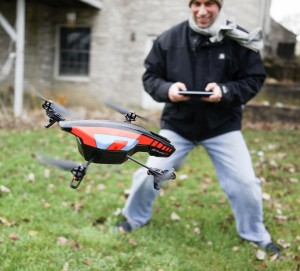The Federal Aviation Administration (FAA) recently released new regulations governing the use of Unmanned Aircraft Systems (UAS). Yes that’s right, that drone you just unwrapped is an aircraft! And as a drone owner, you are now faced with the prospect of operating your drone within these new regulations. The unique thing about drones is that the possibilities are endless, with many potential applications still unexplored. This endless possibility has sent owners on a chase; they want to see what all can be done with their drone. So while you may not have given much thought to the flying you want to do beyond seeing things from above, you never know what applications you might find.
Happy Holidays! You got a drone… now what?
Sixteen year old student pilot Bryan Kruk received a DJI Phantom drone for Christmas. “I had flown with a Syma X5C trainer for several months before, so when I got my Phantom, I was really impressed with the features and I was truly excited to fly it. I had read about all of the regulations on the FAA’s “Know Before you Fly” website. Registration was relatively easy although I know a lot of people disagree with the registration of their quad(copter)s.”
 First off, if you plan to use your drone to make money (in other words, commercially) you can… just not quite yet. Let’s say you just want to fly it around for the fun of it. If your drone weighs more than 0.55LBS and less than 55LBS must be registered with the FAA under their UAS registration system. If your done weighs more than 55LBS you have to register it as an aircraft. Registration for a drone under 55LBS is quick, easy, inexpensive ($5.00), and can be done online.
First off, if you plan to use your drone to make money (in other words, commercially) you can… just not quite yet. Let’s say you just want to fly it around for the fun of it. If your drone weighs more than 0.55LBS and less than 55LBS must be registered with the FAA under their UAS registration system. If your done weighs more than 55LBS you have to register it as an aircraft. Registration for a drone under 55LBS is quick, easy, inexpensive ($5.00), and can be done online.
Now that you’ve registered your drone you can start flying it. You can still take all the photos you want and post them all over social media assuming you follow the basic rules. These basic rules include:
-
Flying the drone AT or BELOW 400FT
-
Not flying the aircraft within 5 miles of an airport (If you intend to fly closer you must contact the ATC facility at that airport as well as the airport’s operator to receive clearance). Remember, there are probably more airports near you than you realize.
-
You must keep the aircraft in your line of sight (even if your drone is equipped with First Person View (FPV))
-
Avoid flying near other aircraft… keep in mind general aviation aircraft fly low and slow often times
-
Avoid flying near groups of people
- DO follow ALL FAA restrictions including Temporary Flight Restrictions (TFRs), they apply to drone operators just as they do to pilots.
- The FAA’s B4UFLY smartphone app can tell you if you’re able to fly in a particular place, as well as being able to link you to things like the list of current TFRs. It is available for iOS and Android.
The Most Important Factor for Safe Flight: Common Sense
Pilots learn a lot in training. However, one thing that cannot be taught is common sense. Fly your drone with common sense and utilize good aeronautical decision making. Before every flight an aircraft undergoes a preflight inspection… preflight your drone. Make sure everything is in working order before you takeoff, make sure the propellers are on securely, make sure the flight controls function, and make sure the battery is fully charged. If you are unsure about anything, don’t fly. Always remember: It is better to be on the ground wanting to fly then to be in the air wanting to be on the ground. Granted your life isn’t at stake in the drone; however, a good bit of money (and your pride as a drone pilot) most likely are. Aeronautical Decision Making (ADM) comes into play when you go to fly the drone. Based on the weather and wind you make a “go, no go” decision on flying your drone. Are there power lines and other obstructions in the immediate area? Are there aircraft near by flying at an altitude you could possibly interfere with? Be smart, pay attention, and fly safe.
Making Money: Commercial Operations
As a private drone operator you cannot use your drone to make money… legally. In fact, in some cases, the FAA has taken a rather strict view regarding what qualifies as a commercial operation. In at least one case, simply uploading a video to a YouTube account with an ad placed before the video was enough to draw the unwanted attention of an FAA inspector.
However, making money with a drone isn’t impossible. In fact, if you follow the proper steps it isn’t all that difficult. Through the FAA’s Modernization and Reform Act of 2012 (FMRA) companies can get an exemption to operate their drone commercially. The Section 333 exemption is granted to companies who file the application and meet the qualifications. The FAA will approve or deny your request after reviewing your application.Get it approved and you can start making money with your drone. As long as you adhere to the FAA’s regulations, you can begin your commercial operation.
Easy enough, right? So what’s the major hold up when filing a Section 333 Petition? The person operating the drone, the pilot in command (PIC), must be a licensed pilot. The pilot must hold at least a Sport Pilot License with the FAA and have a valid medical certificate that corresponds with that license. The Section 333 exemption allows a competitive edge in the world of UAS operations and helps ensure safety. (Editor’s Note: Some of the rules regarding commercial drone operations have changed since this article was originally published)
Drones are seriously excellent machines that can truly improve the way we do a lot of things. If we use them safely and with common sense they can do a lot of good. Please remember to always fly safe, follow the FAA’s regulations, and never fly outside of your personal comfort limits.
For more visit FAA.gov and knowbeforeyoufly.org
Jay Haapala is a High Performance Endorsed FAA Licensed Private Pilot, an Eagle Scout, a high school senior, and a Type One Diabetic (T1D). He is currently working to convince the FAA to allow commercial flying with T1D. He resides in Charleston, WV and works as a commercial drone pilot for a startup company. Jay enjoys public speaking and sharing his story of becoming a licensed pilot despite living with T1D for over 12 years. Jay is 18 and is an avid traveler. Find him on Facebook, Twitter, and Instagram, or visit his blog about flying as a diabetic.
Top image by ArnoldReinhold (Own work) [CC BY-SA 3.0] or GFDL, via Wikimedia Commons
Bottom image by Christopher Michel [CC BY 2.0], via Flickr







